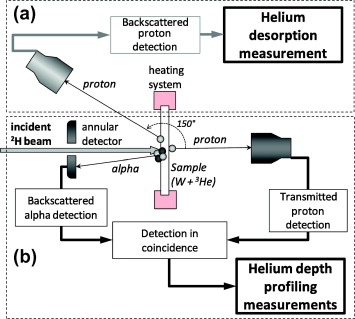Ask for a reprint
email :
* Give your email
2013
ACL
|
P.E.Lhuillier, T.Belhabib, P.Desgardin, B.Courtois, T.Sauvage, M.F.Barthe, A.L.Thomann, P.Brault, Y.Tessier, 'Helium retention and early stages of helium-vacancy complexes formation in low energy helium-implanted tungsten', J. Nucl. Mater. 433 305-313 (2013) doi:10.1016/j.jnucmat.2012.09.001
Tungsten has been selected as the material of the divertor of the ITER fusion reactor. In operation, tungsten will be submitted to high alpha particles bombardment. The consequence of helium implantation is a major issue for the reliability of tungsten components. The aim of the study was to investigate the behavior of helium implanted in tungsten at low energy and low flux. 320 eV Helium ions were introduced by plasma immersion at the flux of 2.5 × 1018 ion/m−2/s−1. The helium behavior was investigated by Nuclear Reaction Analysis and the evolution of the tungsten lattice by Positron Annihilation Spectroscopy (PAS). Helium-implanted tungsten exhibits a low retention rate (13.6% at 9.4 × 1019 He m−2) which decreases with the implantation fluence. The desorption of helium starts at low temperature (<400 K). SEM analysis after annealing over 973 K shows sparse pores probably due to bubbles opening at the surface. The creation of helium-filled defects in the near surface layer (0.5 to ∼20 nm) was followed by PAS. A low level of damages was introduced by 12 MeV proton irradiation, prior to He introduction and allowed to examine the influence of pre-existing defects on the helium trapping. The PAS results suggest that the early stage of the formation of helium-filled vacancy clusters does not require the presence of pre-existing vacancy and thus proceed from the trap mutation phenomenon.
|

|